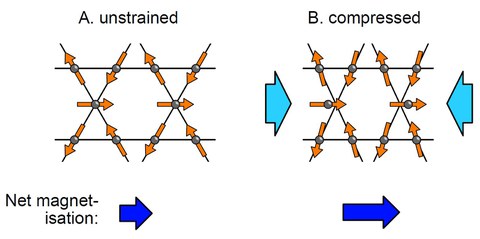Aug 25, 2022
Research: Piezomagnetism in an anomalous Hall antiferromagnet
In collaboration with the group of Prof. Nakatsuji at the University of Tokyo, SFB 1143 PI Clifford Hicks has co-authored a study on the Hall effect of Mn3Sn. Mn3Sn is a strong candidate for magnetic memory. It is an antiferromagnet with a strong Hall effect, which is understood to be a consequence of a large effective magnetic field generated by the antiferromagnetic order– a topological Hall effect. However, Mn3Sn also has a small ferromagnetic moment, which left open the possibility that it was actually this small ferromagnetism and not the antiferromagnetic structure that was responsible for the Hall effect.
In this study, Mn3Sn was placed under uniaxial stress. The uniaxial stress alters bond lengths, causing the magnetic moments to rotate. The antiferromagnetic structure remains much the same, but the net ferromagnetic moment is strongly altered by even a small rotation of the moments. We showed here that the Hall effect tracks the antiferromagnetic order parameter, not the ferromagnetic moment. Topological transport, in which an arrangement of magnetic moments generates an effective magnetic field far larger than the magnetic fields actually present in the sample, is a major area of current research, due in particular to the possibility of generating memory elements with low stray magnetic fields. This research confirms topological transport in Mn3Sn.
M. Ikhlas, S. Dasgupta, F. Theuss, T. Higo, B. J. Ramshaw, O. Tchernyshyov, C. W. Hicks, S. Nakatsuji,
Piezomagnetic switching of the anomalous Hall effect in an antiferromagnet at room temperature,
Nat. Phys. (2022) (arXiv)

